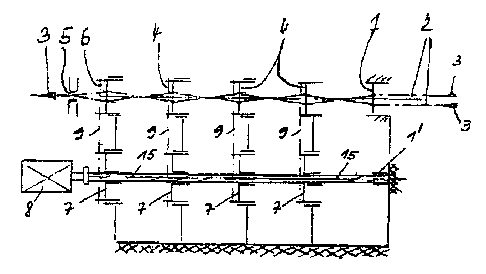Some of the information on this Web page has been provided by external sources. The Government of Canada is not responsible for the accuracy, reliability or currency of the information supplied by external sources. Users wishing to rely upon this information should consult directly with the source of the information. Content provided by external sources is not subject to official languages, privacy and accessibility requirements.
Any discrepancies in the text and image of the Claims and Abstract are due to differing posting times. Text of the Claims and Abstract are posted:
| (12) Patent: | (11) CA 2200861 |
|---|---|
| (54) English Title: | DEVICE FOR MAKING A WIRE STRAND WITH CHANGING TWIST DIRECTION |
| (54) French Title: | DISPOSITIF DE TORONNAGE DE CABLES EN SENS ALTERNE |
| Status: | Expired and beyond the Period of Reversal |
| (51) International Patent Classification (IPC): |
|
|---|---|
| (72) Inventors : |
|
| (73) Owners : |
|
| (71) Applicants : |
|
| (74) Agent: | SMART & BIGGAR LP |
| (74) Associate agent: | |
| (45) Issued: | 2003-08-12 |
| (86) PCT Filing Date: | 1995-06-28 |
| (87) Open to Public Inspection: | 1996-01-11 |
| Examination requested: | 2002-04-18 |
| Availability of licence: | N/A |
| Dedicated to the Public: | N/A |
| (25) Language of filing: | English |
| Patent Cooperation Treaty (PCT): | Yes |
|---|---|
| (86) PCT Filing Number: | PCT/AT1995/000137 |
| (87) International Publication Number: | WO 1996000970 |
| (85) National Entry: | 1997-03-24 |
| (30) Application Priority Data: | ||||||
|---|---|---|---|---|---|---|
|
A device for stranding cables from individual wires with alternate directions
of lay (SZ stranding) in which there are a fixed guide (1) with drillings to
accept the individual wires and several spaced storage discs (4) drivable in
alternate directions and also with drillings to accept the individual wires to
be stranded or a laying disc (6) drivable via drive discs (7) and transmission
components (9), in which there is a common drive (8) for at least some of the
drive discs (7), whereby there is a torsion elastic shaft (15) of any cross-
section between the drive (8) and the drive discs (7).
L'invention concerne un dispositif de toronnage de câbles en sens alterné (câblage SZ), à partir de fils individuels, qui comprend un guide (1) fixe comportant des trous pour recevoir les fils individuels, et des disques de stockage (4) disposés à distance les uns des autres, entraînables dans des sens alternés et également pourvus de trous pour recevoir les fils individuels à toronner, ou bien un disque d'alimentation (6). Ces disques peuvent être entraînés par l'intermédiaire de poulies motrices (7) et d'éléments de transfert (9). Il est prévu un système d'entraînement commun pour au moins une partie des poulies motrices (7), un arbre (15) élastique en torsion de section quelconque étant disposé entre le système d'entraînement (8) et les poulies motrices (7).
Note: Claims are shown in the official language in which they were submitted.
Note: Descriptions are shown in the official language in which they were submitted.

2024-08-01:As part of the Next Generation Patents (NGP) transition, the Canadian Patents Database (CPD) now contains a more detailed Event History, which replicates the Event Log of our new back-office solution.
Please note that "Inactive:" events refers to events no longer in use in our new back-office solution.
For a clearer understanding of the status of the application/patent presented on this page, the site Disclaimer , as well as the definitions for Patent , Event History , Maintenance Fee and Payment History should be consulted.
| Description | Date |
|---|---|
| Time Limit for Reversal Expired | 2015-06-29 |
| Letter Sent | 2014-06-30 |
| Inactive: Office letter | 2007-02-27 |
| Inactive: Corrective payment - s.78.6 Act | 2007-01-19 |
| Grant by Issuance | 2003-08-12 |
| Inactive: Cover page published | 2003-08-11 |
| Pre-grant | 2003-05-23 |
| Inactive: Final fee received | 2003-05-23 |
| Inactive: Adhoc Request Documented | 2003-02-21 |
| Inactive: Office letter | 2003-02-21 |
| Inactive: Correspondence - Prosecution | 2003-01-15 |
| Notice of Allowance is Issued | 2002-12-03 |
| Letter Sent | 2002-12-03 |
| Notice of Allowance is Issued | 2002-12-03 |
| Inactive: Approved for allowance (AFA) | 2002-11-25 |
| Amendment Received - Voluntary Amendment | 2002-10-17 |
| Amendment Received - Voluntary Amendment | 2002-10-07 |
| Inactive: S.30(2) Rules - Examiner requisition | 2002-06-17 |
| Letter Sent | 2002-06-12 |
| Inactive: Entity size changed | 2002-06-07 |
| Amendment Received - Voluntary Amendment | 2002-05-09 |
| Request for Examination Received | 2002-04-18 |
| Request for Examination Requirements Determined Compliant | 2002-04-18 |
| All Requirements for Examination Determined Compliant | 2002-04-18 |
| Letter Sent | 1997-09-24 |
| Inactive: Single transfer | 1997-07-28 |
| Inactive: Notice - National entry - No RFE | 1997-06-19 |
| Inactive: IPC assigned | 1997-06-18 |
| Inactive: First IPC assigned | 1997-06-18 |
| Inactive: Notice - National entry - No RFE | 1997-06-10 |
| Inactive: Courtesy letter - Evidence | 1997-04-29 |
| Application Published (Open to Public Inspection) | 1996-01-11 |
There is no abandonment history.
The last payment was received on 2003-05-21
Note : If the full payment has not been received on or before the date indicated, a further fee may be required which may be one of the following
Please refer to the CIPO Patent Fees web page to see all current fee amounts.
Note: Records showing the ownership history in alphabetical order.
| Current Owners on Record |
|---|
| BERGSMANN, LUDWIG |
| Past Owners on Record |
|---|
| GERHARD SEIBERT |